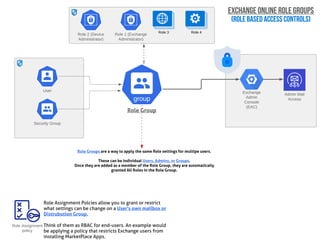Exchange Role Based Access using Role Groups
- 1. Role Assignment Polcies allow you to grant or restrict what settings can be change on a User's own mailbox or Distrubution Group. Think of them as RBACfor end-users. An example would be applying a policy that restricts Exchange users from installing MarketPlace Apps. Role Groups are a way to apply the same Role settings for multipe users. These can be individual Users, Admins, or Groups. Once they are added as a member of the Role Group, they are automatically granted All Roles in the Role Group. E xchangeO nlineR oleG roups (R oleB asedaccesscontrols) Role 3 Role 4 Role Group User Role 2 (Device Administrator) Role 1 (Exchange Administrator) Security Group Exchange Admin Console (EAC) Role Assignment policy Admin Mail Access

